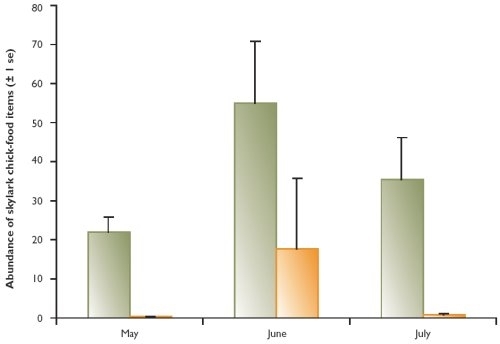 Winter wheat is a poor habitat for birds because the dense canopy shades out weeds, there are few insects, and it prevents access for birds like skylarks.
Winter wheat is a poor habitat for birds because the dense canopy shades out weeds, there are few insects, and it prevents access for birds like skylarks.
Two approaches that would open the canopy are being tested. These are: undrilled four metre by four metre patches and wide-spaced rows with 25cm spacing.
The study found that undrilled patches did not contain consistently more invertebrates than the neighbouring crop (see Figure 1) and invertebrate abundance did not differ between fields containing wide-spaced rows, standard rows or undrilled patches.
In both years the weed cover of the preferred species was higher (8 and 13%) in the undrilled patches compared with 1% or less in the conventional or wide-spaced rows, but these weeds supported few invertebrates. Where there were more weeds in the field overall, then this led to an increase in the abundance of predatory and herbivorous insects, many of which are eaten by farmland birds.
Figure 1: Abundance of invertebrates important in the diet of skylark chicks in undrilled patches and the adjacent crop in 2002 (top) and 2003 (bottom)


We think that undrilled patches would be more useful if the cover of the more desirable weeds could be increased, so improving their value as a foraging resource for birds. However, the patches form only 0.3% of the field and raising the levels of weed cover within the crop may encourage the invertebrate food supplies better. Linked to this, we are experimenting with herbicides and cultivation to try to produce a more desirable weed flora within winter wheat crops.
The BTO and RSPB found that the skylark breeding season was longer in the fields with undrilled patches and their productivity was higher than in conventional fields. Later in the breeding season, nests in these fields produced an average of 1.5 more chicks per attempt than those in the conventional fields. This was probably because of the better access rather than an increased food supply.